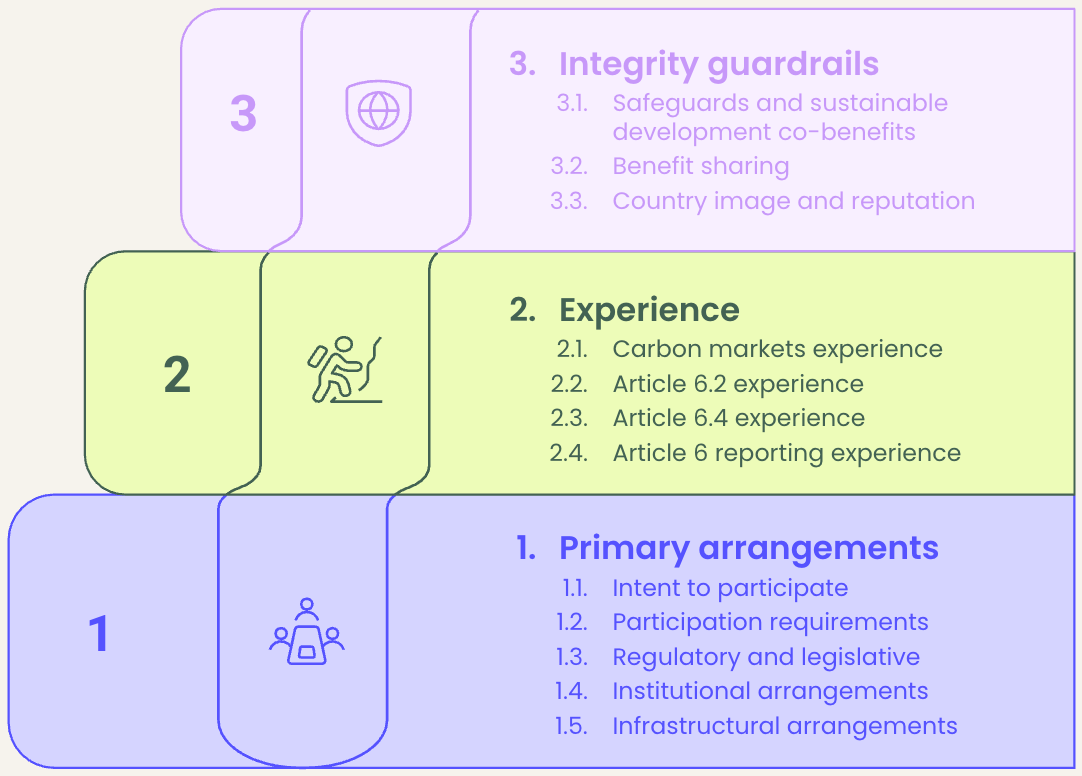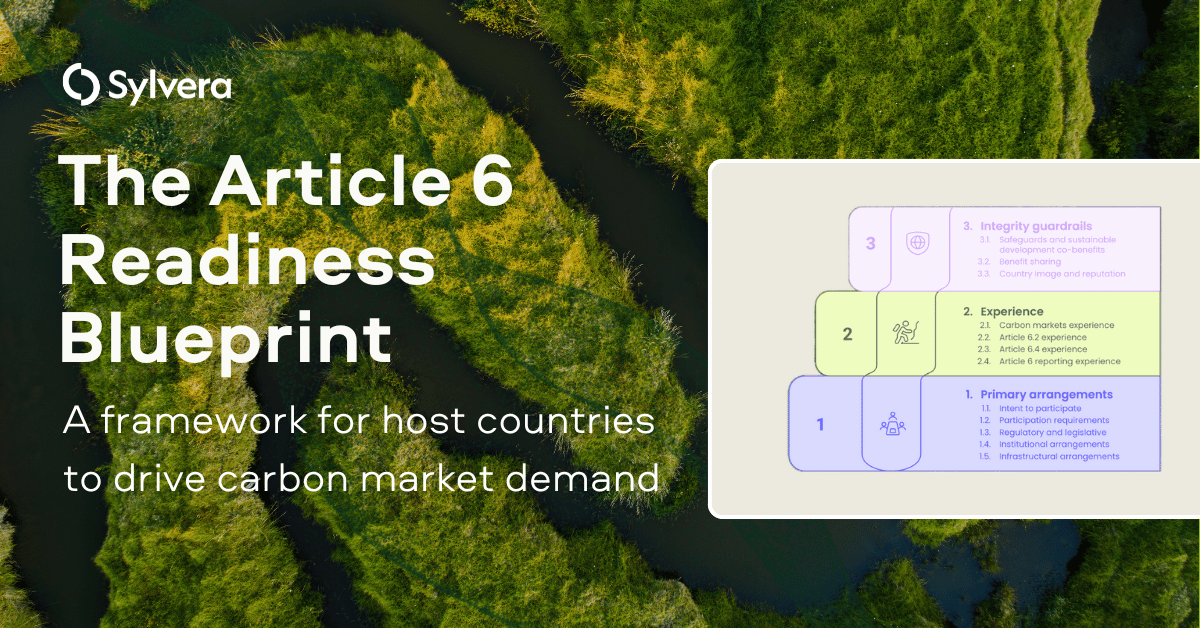「私たちは長年にわたり、信頼できる格付けの提供に注力し、現地データチームへの投資を重ねてきました。これにより当社の格付けの正確性は確保されていますが、購入者が検討している数千のプロジェクトにわたるスケールを実現することはできません。」
カーボンクレジット調達の最新動向について詳しくは、当社の記事「Key Takeaways for 2025」をご覧ください。調達戦略を改善するための、データに基づく5つのヒントをご紹介しています。

加えて:Connect to Supplyをご利用のお客様は、Sylveraのその他のツールもご利用いただけます。プロジェクトの格付け確認や強みの評価、高品質なカーボンクレジットの調達に加え、プロジェクトの進捗状況のモニタリング(特に発行前段階で投資している場合)も可能です。
Sylveraの無料デモを予約して、調達機能やレポーティング機能を体験しましょう。
高まる第6条への準備の必要性
バクーで開催されたCOP29での第6条規則の最終決定を受け、国際炭素市場は重要な実施段階に入ろうとしています。すでに30の二国間協定が調印され、パリ協定クレジット発行メカニズム(PACM)がクレジットの発行を開始する予定であることから、ホスト国はこれらのメカニズムに効果的に参加する用意があることを実証する必要に迫られています。
しかし、ホスト国の準備態勢が整っていないという大きな課題も残っています。このギャップは、カーボンクレジット 買い手にとってかなりの不確実性を意味します。このギャップは、市場への参加を制限するだけでなく、市場の供給サイドを制約するものでもあります。
多くの途上国(一般的に炭素プロジェクトの大半をホストしている)は、対応する調整、新たな報告義務、緩和成果の二重計上を防ぐ必要性など、パリ協定によって導入された複雑な要件に苦慮しています。
利害関係は大きい。政府バイヤーはカーボンクレジット 調達の完全性に関する監視の強化に直面し、民間セクターは進化するコンプライアンス要件をナビゲートする必要があります。
一方、受入国は、第6条の需要を惹きつけるためにどのような重要な要素が必要なのかが明確でないことが多く、バイヤーの要件が多様であることがこの課題を悪化させています。
第6条準備の青写真の紹介
このような課題に対処するため、気候行動センター・オブ・エクセレンス(CACE)とともに、私たちは包括的な第6条準備ブループリントを開発しました。 第6条準備の青写真.これは、ホスト国が需要と投資を呼び込むための理想的な環境を育成するための指針となる共通の枠組みです。この青写真は、バイヤー、投資家、能力開発イニシアティブのための貴重な評価ツールとしても機能します。

青写真では、準備態勢の指標を相互に関連する3つのカテゴリーに整理しています:
1.主な取り決め財団
一次的取り決めとは、各国が第6条を運用するための基礎となる国内制度のことです。以下のものが含まれます:
- 参加の意思:第6条メカニズムへの明確な政治的・戦略的関心の表明
- 参加条件UNFCCC第6条に参加するための正式な条件を満たすこと
- 規制と法的取り決め第6条の活動を規制する法的枠組み
- 制度的な取り決め:明確な役割、責任、調整構造
- インフラの整備緩和成果のモニタリング、追跡、報告システム
2.経験実践
主要な取り決めが理論的な構造を提供する一方で、真の準備態勢は実践的な適用を通じて明らかになります。経験の指標は以下の通り:
- 炭素市場の経験炭素価格メカニズムおよびプロジェクト開発に携わった経験
- 第6条2項の経験:協力的アプローチと二国間協定の実証された経験
- 第6.4条の経験クリーン開発メカニズムまたはPACM活動への参加
- 第6条報告の経験透明性と報告要件を満たした実績
3.高潔性のガードレール信頼性の確保
現代の炭素市場では、環境および社会的整合性が不可欠となっています。主なガードレールは以下の通り:
- セーフガードと持続可能な開発のコベネフィット:環境・社会リスクを管理する強固なシステム
- 利益の分配:炭素市場の収益を分配するための公平なメカニズム
- 国のイメージと評判:国際的地位、ガバナンスの認識、気候変動に対する野心
ダウンロード ホスト国の第6条準備:需要促進のための重要な側面

ステークホルダーが青写真を活用する方法
ホスト国のために
この青写真は、第6条への準備態勢を強化しようとする各国政府のための包括的なチェックリストです。各国はこれを利用して
- 準備態勢のギャップを特定し、能力構築努力の優先順位を決定するための自己評価の実施
- 国際的なベストプラクティスに沿った国内第6条戦略の策定
- 潜在的なバイヤーやパートナーへの準備状況の伝達
- 制度的な能力を構築しながら、長期的に進捗を追跡
代表的な例としては、ガーナの条件付きNDC措置とポジティブ/ネガティブ活動リストによる構造的アプローチ、タイの国内炭素登録簿とスイスとの最初のITMO取引による早期の運用開始などが挙げられます。
企業バイヤーおよび投資家の皆様へ
このフレームワークは、受入候補国を評価する組織にとって不可欠なデューデリジェンス基準を提供するものです:
- リスク評価プロジェクト実施とITMOデリバリーが成功する可能性の評価
- 品質保証環境保全と社会的セーフガードの評価
- ポートフォリオの多様化:複数の司法管轄区にまたがる準備レベルの比較
- 長期計画:準備指標を改善する新興市場の特定
プロジェクト開発者向け
プロジェクト開発者は、この青写真を使って次のことができます:
- 市場の選択:制度的枠組みの強い国を優先
- パートナーシップ戦略:地域の能力格差と協力の機会の特定
- プロジェクトの設計国の優先事項および規制要件に沿った活動
- タイムラインの計画:規制プロセスと承認スケジュールの予測
能力開発組織のために
青写真は、既存のイニシアチブを調整するのに役立ちます:
- 国の進捗を測定するための共通の評価基準
- 対象となる技術支援の優先順位の特定
- キャパシティビルディング介入策のインパクト測定
- 複数の支援提供者間の調整メカニズム
実例と成功例
青写真の原則をすでに実践している国もいくつかあります。カンボジアは、最近UNFCCCに初回報告書を提出し、指定された管轄当局や利益配分メカニズムを含む第6条の枠組みの概要を明確に示しました。ガーナは、最も包括的な国家的枠組みの一つを策定し、第6条の活動を条件付きNDC措置と明確に関連付けるとともに、肯定的活動リストと否定的活動リストを明確に定めました。
141のODA対象国を分析した結果、ガーナ、ケニア、カンボジア、ルワンダ、ザンビアが、主要な取り決めと経験の基準に基づいて最も進んでいる国であることが判明しました。
第6条準備態勢の完全な枠組みをダウンロード
この青写真は、炭素市場の実務家の専門知識を集約したものであり、6条の初期の実施から得られた新たなベストプラクティスを反映したものです。完全なフレームワークには、準備態勢の各要素に関する詳細なガイダンス、各国のケーススタディ、評価と実施のための実践的なツールが含まれています。
ダウンロード ホスト国の第6条準備:需要促進のための重要な側面をダウンロードして、第6条準備態勢の構築に関する包括的なガイダンス、詳細な国別事例、全ての利害関係者のための実行可能な提言にアクセスしてください。
















